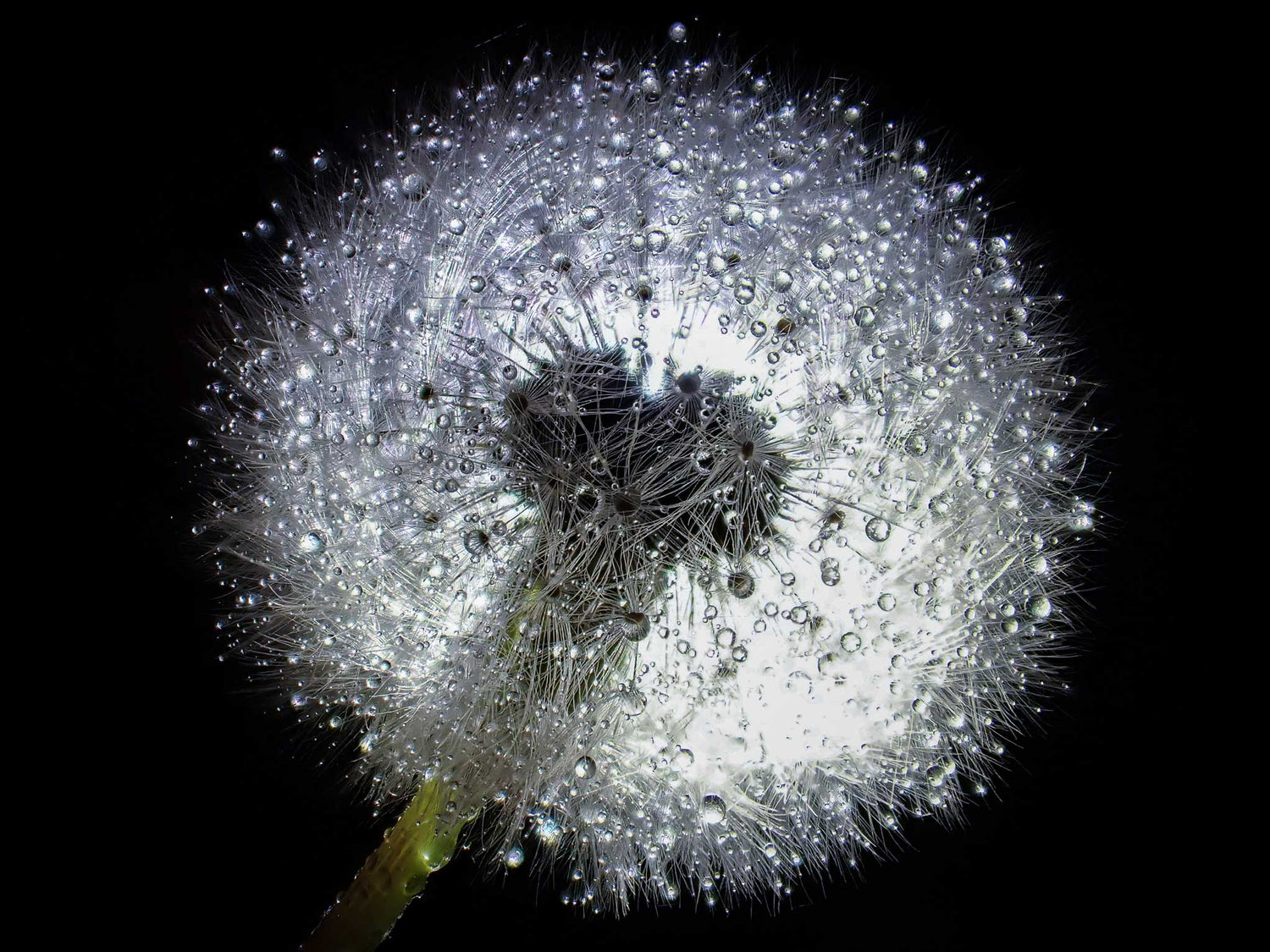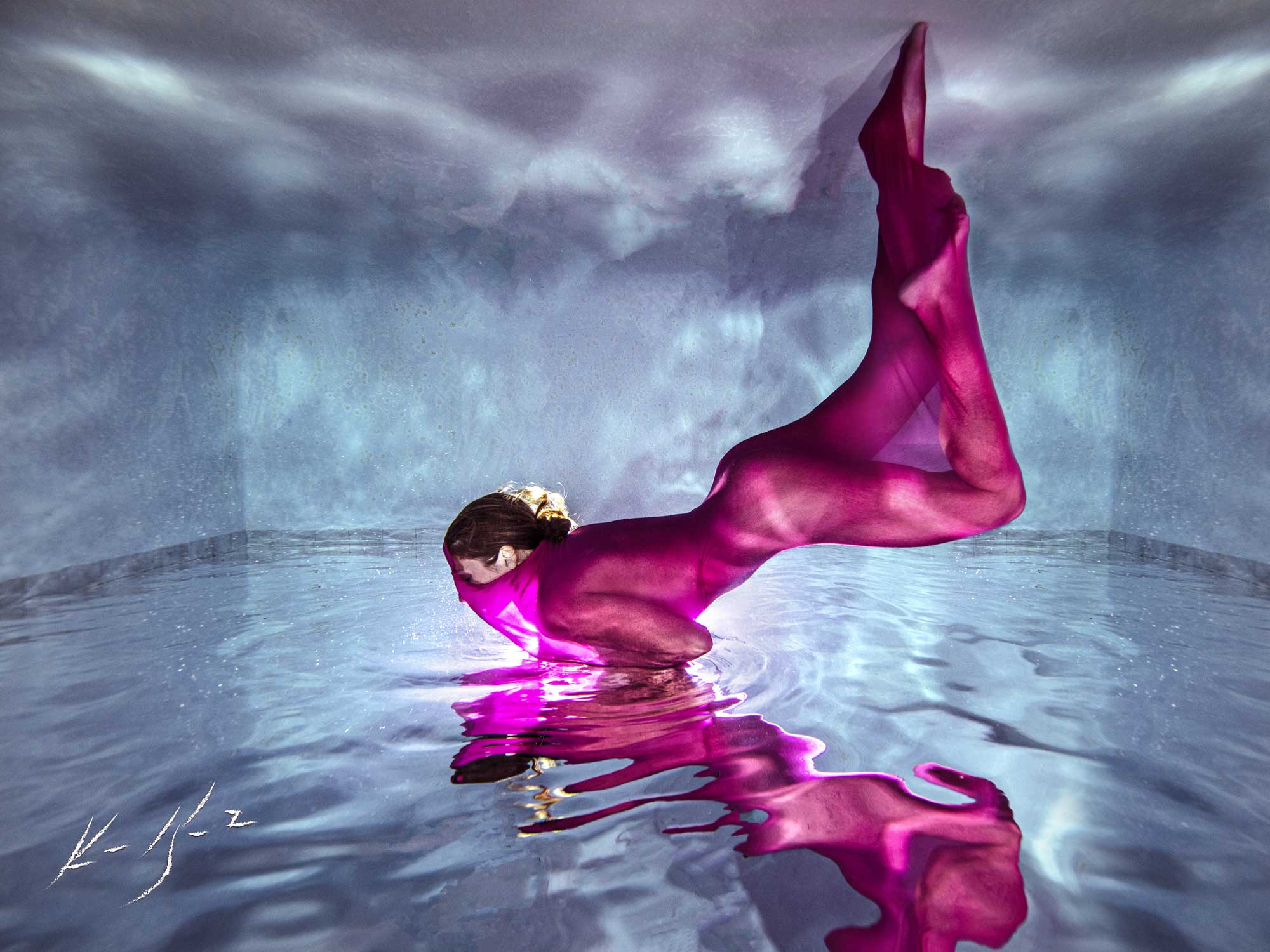Misted, frozen Dandelion focus stacked. Ambassador Steve Miller has been very pleased with how easy the stacking function in the Olympus Tough TG-6 Microscope mode works. In this image he tried misting a dandelion and then sticking it in the freezer to see if ice crystals might be interesting. That didn’t work, but holding a Gamma light behind it for backlighting combined with the focus stacking made an interesting view. Photo copyright © 2020 Steve Miller
It's mid-May and spring is here about 50% of the time here in Indiana. Our state government is starting to loosen the restrictions on movement and some may even dare to eat inside a restaurant soon (not us though, we're still hard at work for you).
This week we find out what kind of photos and videos our Ambassador team is working on while their passports are getting a much-needed rest.

Marcel Rudolph-Gajda has been working on ways to photograph ocean life without the ocean or the life, but not lacking in creativity or movement. Photo © 2020 Marcel Rudolph-Gajda
Marcel Rudolph-Gajda | Hamburg, Germany
Well, it’s been awhile since Germany went to lockdown. The beginning of this period is still a blur as the whole family got H1N1, better known as the bird flu. After three weeks into lockdown we‘re all back on the horse again and still stayed home. A new adventure of sorts, as we had been on parental leave with the now 4 years old in Tonga and New Zealand for four months (she turned one in Auckland) and with the now 2 years old (and of course his big sister) we went to South Africa for three months a year ago.
But being home with them while also doing our full-time jobs was and is something totally different. Imagine a high-speed drift dive with vertical currents. It’s a wild ride.

Studies of backyard animals including squirrels and birds are a common theme among our among our Ambassadors while they're dry-docked. Photo © 2020 Marcel Rudolph-Gajda
Luckily we have a garden with some cool wildlife. I‘ve never taken so many pictures of squirrels, birds, and the occasional rabbit or even buzzard.
Also we created our very own underwater world in a bathtub and I heavily invested in marine life figurines.
Thinking back two months we were packing for a family scuba trip to Thailand and I was about to start ocean talks at kindergartens. As Germany now slowly opens up I am craving to get some saltwater around me to take my new Sony Alpha A7R IV in it‘s brand new Ikelite 200DL housing for a photo session. I don’t know where this will be but I am sure it will be some of the best dives of my life.

Bright yellow goldfinches are entertaining Lindsey Dougherty in her backyard in Colorado. Photo © 2020 Lindsey Dougherty
Lindsey Dougherty | Boulder, Colorado, USA
I was actually supposed to be in Grand Cayman right now diving with my mom, so I'm missing the ocean even more than normal. In typical Colorado fashion, I was playing with my golden retriever Sailor in a kiddie pool in the backyard one day in 75 degree weather, and a couple days later there was 14" of snow in Boulder haha.
The kiddie pool is decorated with sharks wearing sunglasses, so sadly that's the closest I've gotten to marine life since the shutdown. However, I'm still able to work on my photography since the backyard is full of beautiful goldfinches. Other than swimming, playing in the snow, and taking photos, I continue to teach Tropical Marine Ecology for the University of Colorado (online), and am working with the Ocean First Institute and Ocean First Education to continue to provide marine online learning opportunities for students (most recently working on invasive species, featuring Lionfish!).

This is a far cry from the Cayman Islands but it will have to do. In Colorado you have to take full advantage of the warm days because the pool could be iced over tomorrow. Photo © Lindsey Dougherty
I'm also helping a woman from BBC Planet Earth III work on a plan to highlight the wonderfully fun yellowhead jawfish, for which I posted an Ikelite and Scientific American story. In other exciting news, Wired recently featured a story about my research on disco clams, and they may be featured on a Japanese TV show called "Unbelievable" - which they most certainly are!

Sharing is caring. Goldfinches at a bird feeder in Lindsey Dougherty's backyard. Photo © 2020 Lindsey Dougherty
Finally, my mom and I are working on a children's book which I wrote and she illustrated, so I'm trying to stay as close to the ocean as possible here in land-locked, condo-locked Colorado. Best wishes and tropical fishes to all - stay healthy and can't wait to get back underwater soon! :)

You think you have a lot of photos and video to go through? Jacques de Vos goes through over 40TB of footage to update his stock photo & video galleries. Photo © 2020 Jacques de Vos
Jacques de Vos | Tenerife, Spain
We have been under strict lockdown for many weeks - we have it a bit tougher than most countries in that this whole time we have not even been allowed to go for a quick walk (alone) and you are literally only allowed out of the house to go to a supermarket in your area (i.e the closest one), to relieve your dogs on the sidewalk, and to care for the elderly. It's pretty hectic and they even police the coastline and beaches with helicopters to find people breaking the rules. We have also seen the military in full armored Humvees driving through even the smallest towns every few hours.
Yup, its been a long few weeks and really keeping our fingers crossed there is an end in sight. I have just been at the PC editing photos from the last season as well as a video for Panasonic which will premiere in the near future. Here's a shot of some of my drives from the last few years (each either 3 or 4 TB in this shot!) as I have been spending a lot of time going through old material to upload as stock footage / images. Tedious and a long term investment, but as good a time as any :)
From November through February, Jaques de Vos and Arctic Freediving lead expeditions to swim with Orcas and Humpback Whales off the coast of Norway. Here's some touching footage of an orca calf swimming to meet up with its mamma. Video © 2020 Jacques de Vos.
Ashley Siana | Bozeman, Montana, USA
As the Montana snowmelt has blown out all the rivers, there have been very few underwater photography opportunities in the Mountains. So, I've spent quarantine doing the next best thing, editing underwater footage. The film I'm working on is about Maine's lobster industry and the ecological impacts climate change is having on the Gulf of Maine. I feel lucky to have editing during the COVID lock down, both as a source of income and as a form of stress release, as it provides a virtual escape to the underwater world.
Ashley Siana is currently pursuing her Masters in Science & Natural History Filmmaking at Montana State University. These are some clips from a film she is working on about the Maine lobster fishing industry and the effects of climate change on Maine's coast. Video © 2020 Ashley Siana

Turtle in a pot. This is a rough draft for an image Steve Miller is trying to make in a “tiny scene.” Basically a lily pot full of rocks. The attempt is to use forced perspective to create the illusion of something larger with the Olympus TG-6 and FCON-T02 Fisheye lens. Now he just needs to figure out how to create light rays. This image is just a couple gradient filters in Adobe® Lightroom. A natural beam of light could make the scene work better. Photo Copyright © 2020 Steve Miller
Steve Miller | Cincinnati, Ohio, USA
In my backyard I have a pair of bluebirds with babies that are going to fledge in the next day or two... I’ve been shooting the crap out of them!! I have video, slo-mo, wide lens, close, etc. feeding, flying... :-) They are perfectly normalized to the tripod, etc. -and will even perch on it, but don't want you to stand too close. The best solution I’ve found is to control the camera with the phone, or let it roll, walk away, then delete a lot when you come back. This makes still images actually harder to get than video.
I have also been working on my underwater “tiny scene” project with pots full of rocks before the bluebirds started. Basically I'm just setting up a miniature environment. Then I can shoot a small subject from very close up using the Olympus TG-6 with the FCON-T02 fisheye lens. The turtle shot above was actually a lame attempt at adding light rays in post-production using Adobe® Lightroom. It’s just two gradient filters. I’ve been watching some Photoshop tutorials on how to make them, but I need to figure out how to block the sun on a sunny to create natural looking real rays- and then simply enhance them. One of the pots is on a lazy Susan (it spins) so I can move the sun around in the frame.

Dry Dandelion focused stacked. “Focus stacking is a pretty elaborate Photoshop process where many images are taken from the same vantage point at different distance settings of focus. These images are then combined emphasizing the sharp areas from each image. This results in depth of field unobtainable any other way for a very deep, almost 3D look. The Olympus TG-6 has a Focus Stacking setting in the Microscope mode that produces focus stacked images with a single click- all in camera.” ..very, very cool. Photo © 2020 Steve Miller
A compilation of close-up, wide angle, slow motion, and time lapse shots of bluebirds feeding in a backyard bird feeder. Video copyright © 2020 Steve Miller
Keep Reading: COVID-19 Check-In | Ambassadors, Part 4
Related Article: COVID-19 Check-In | Ambassadors, Part 1
Related Article: COVID-19 Check-In | Ambassadors, Part 2
Stay tuned for more from the Ambassador team. We also want to hear what you're doing! Send us your story and a couple of photos for the next COVID-19 Check-In | Customer edition!
Additional Reading
Maldivian Tuna Fishing Documentary
Freediving with Orcas in Norway
Capturing the Elusive Mouth Brooding Jawfish
How to Photograph Dogs Underwater
Yellowstone Invader | The Destruction of Non-Native Lake Trout
Building the Next Generation Backyard Underwater Photo Studio












![Under Pressure | The Art of Underwater Filming with Matt Jacobs [VIDEO]](http://www.ikelite.com/cdn/shop/articles/matt-jacobs-under-pressure.jpg?v=1645885213&width=1440)
